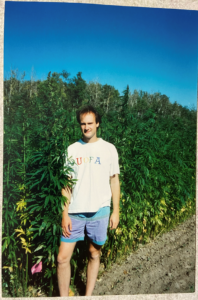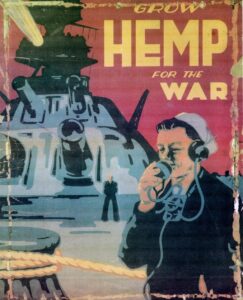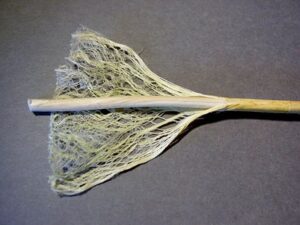I am often asked the question: why hemp? Well, it’s the plant of a thousand (or more) uses; it’s one of the first cellulose fibres used by mankind to make textiles1 and paper (the first bible was printed on hemp!2); it’s seed has the perfect ratio of Omega 6: Omega 3 (3:1)3; it’s high in protein4; when used as cattle feed, cows produce fewer methane emissions5; it’s ideal for soil remediation6; it’s stronger than steel7; it’s carbon sequestering, making it a carbon neutral plant8; it’s great for cultivation in temperate, subtropical, and tropical climates9; …shall I go on? Essentially, it’s the perfect plant. And we need it in our lives.
I grew up on a farm near Two Hills, Alberta. My parents encouraged me and my three siblings (me being the youngest) to learn and understand the natural world around us. While my mom was a chemist by trade, her true passion was botany, and that passion was definitely passed on to all of her children. We would spend hours foraging for mushrooms, berries, wild garlic, caragana flowers…if it was edible, we ate it. My mom also encouraged us to experiment growing different plants. I still remember the summer she bought me bamboo seeds. I was so excited. Out of 10 seeds, 4 germinated. They only grew to be around 2 feet tall, but they still grew!
Back to hemp – my mom often talked about growing hemp when she was a child. She was born in 1945. In 1938, the cultivation of cannabis in Canada, including industrial hemp, was banned in accordance with the Opium and Narcotic Drug Act; this ban was lifted briefly for WWII efforts between 1942 – 1945. Industrial hemp flourished during this time, and it was used for a multitude of uses – rope, fabric, reinforcement applications, paper. The ban was put back into place after the war ended, but many farmers continued to cultivate this plant for personal uses, primarily for making rope. My mom often reminisced about this plant, commenting on how it grew much taller than her father. In the fall, they would use the coarse stems that were not usable for ropes as firewood, and she commented on how “nice it smelled”, which we often joked about saying “are you sure it wasn’t marijuana?”. Looking back on this conversation, I now understand where the stigma lies between industrial hemp and its THC-rich cannabis cousins. And this is something we need to change in our society (which is happening slowly, but surely).
Around 1994/95, my brother was working for a seed company that supplied regulated industrial hemp seed for field-scale research plots. These crops were highly secured and monitored. No one knew much about industrial hemp at that time, and most people thought these crops were marijuana since the leaf shape is similar. My mom had asked my brother for a tour. She loved anything that involved nature, but hemp was definitely close to heart. They would tell the story of how they drove up to the gate of the hemp farm, got out of the vehicle, and as my mom took her camera out (she carried that camera everywhere), a booming voice came through an intercom stating: “Put the camera away and leave the property. If you fail to do so, reinforcements will be sent”. She did manage to snap a quick photo of my brother, though!

My brother standing proudly; photo credit to my mom circa 1994/95.
When I left home in 1996 to attend the University of Alberta, I was reintroduced to the world of hemp. I can’t remember how many necklaces and bracelets I knotted (macrame) together made from hemp string. Walking along Whyte Avenue, I remember stepping into a “hippy” store that sold all things cannabis related, and I picked up a poster with the slogan: “Grow Hemp for the War”. This was part of the USDA’s 1942 Hemp for Victory campaign, an initiative to encourage farmers to grow industrial hemp towards WWII efforts. This poster moved with me every time I moved, until it became too ragged and torn from being tacked up and pulled off dormitory and apartment walls. I miss that poster, as it reminded me of my mom’s stories; it also made me realize that there was something amiss in our society. I could buy industrial hemp string for crafting, but where were all the other hemp products?

USDA 1942 Hemp for Victory Campaign (Image: Grow Hemp for the War, accessed November 23, 2022)
Bring on 1998 – Canada legalized the cultivation of industrial hemp. This was a very exciting time. This meant that we would see hemp everywhere again in society, right? Well, change happens slowly, but that didn’t stop me from getting my hands dirty. In my fourth year of university, I spent a large portion of my time working on an independent project investigating various wet retting techniques, which is a process of breaking down the pectins (aka plant glue) that hold the bast fibres in place. This is an essential process for fibre collection from industrial hemp stalks, and there are various methods of retting, including field/winter/weathered (hemp straw is left on the fields for natural retting) and chemical retting. In the controlled lab setting I worked in, bast fibres, stripped away from the hurd, would stew in water baths for varying lengths of time (I still remember the eau de retting – the smell was reminiscent of sewer gas, and it would seep into my skin and clothes). After retting, I would painstakingly separate individual fibrils to a specific diameter and mount them in a paper frame for tensile testing. What these results demonstrated was hemp could be viable as a fibre source for textiles, composites, and other applications. Slow progress, but progress none the less.

Hemp stalk (Image: Natrij—Public Domain, Hemp Stalk, accessed on 1 November 2022)
20 years later, in 2018, cannabis restrictions were lifted. Industrial hemp and cannabis are both regulated under Health Canada; while this allows for more opportunities for industrial hemp cultivation, there are still restrictions. Farmers are still dealing with complicated crop licensing and loopholes. At the recent Canadian Hemp Trade Alliance Conference in Saskatoon, it was recommended that industrial hemp be regulated under Agriculture and Agri-Food Canada. This change needs to happen for this industry to move forward and capitalize on this amazing plant.
There are so many opportunities for industrial hemp. At Davey Textile Solutions, we are investigating the utilization of hemp straw and biomass towards regenerated cellulosics (lyocell). If you’re interested in some light reading, here’s a link to a paper we just published outlining why we need to use industrial hemp for this purpose and what it means for the Canadian (and global) economy: Cellulose Textiles from Hemp Biomass: Opportunities and Challenges.
I’m hopeful that industrial hemp will flourish in the Canadian landscape. I’m hopeful that we will begin to see increased use of this amazing plant for the thousand+ uses. And I’m hopeful we will all be wearing clothing made from hemp in the near future. I will continue learning about industrial hemp and educating people as to why they need this plant in their lives. My mom would have been proud.
—
About the author: Lelia Lawson is the Research & Development Specialist at Davey Textile Solutions Inc. in Edmonton, Alberta. She has a MSc in Textiles and Clothing (Human Ecology) and a BSc in Human Ecology, both from the University of Alberta. Her experience in the textile industry spans over 20 years, specializing in industrial personal protective clothing.
References:
(1) Skoglund, G.; Nockert, M.; Holst, B. Viking and Early Middle Ages Northern Scandinavian Textiles Proven to Be Made with Hemp. Sci Rep 2013, 3 (1), 2686. https://doi.org/10.1038/srep02686.
(2) Hemp paper. Wikipedia. https://en.wikipedia.org/w/index.php?title=Hemp_paper&oldid=1114046121 (accessed 2022-11-23).
(3) Rodriguez-Leyva, D.; Pierce, G. N. The Cardiac and Haemostatic Effects of Dietary Hempseed. Nutr Metab (Lond) 2010, 7, 32. https://doi.org/10.1186/1743-7075-7-32.
(4) House, J. D.; Neufeld, J.; Leson, G. Evaluating the Quality of Protein from Hemp Seed (Cannabis Sativa L.) Products Through the Use of the Protein Digestibility-Corrected Amino Acid Score Method. J. Agric. Food Chem. 2010, 58 (22), 11801–11807. https://doi.org/10.1021/jf102636b.
(5) Wang, S.; Kreuzer, M.; Braun, U.; Schwarm, A. Effect of Unconventional Oilseeds (Safflower, Poppy, Hemp, Camelina) on in Vitro Ruminal Methane Production and Fermentation. J Sci Food Agric 2017, 97 (11), 3864–3870. https://doi.org/10.1002/jsfa.8260.
(6) Linger, P.; Ostwald, A.; Haensler, J. Cannabis Sativa L. Growing on Heavy Metal Contaminated Soil: Growth, Cadmium Uptake and Photosynthesis. Biologia plantarum 2005, 49 (4), 567–576. https://doi.org/10.1007/s10535-005-0051-4.
(7) Vivek, V. Is Hemp Really Stronger Than Steel? How?. Hemp Foundation. https://hempfoundation.net/is-hemp-really-stronger-than-steel-how/ (accessed 2022-11-23).
(8) Speicher, S. Hemp Is a Strong Option for Sequestering Carbon. Lancaster Farming. https://www.lancasterfarming.com/news/main_edition/hemp-is-a-strong-option-for-sequestering-carbon/article_29e4d6d0-bcae-5ca6-bb76-0963c470ffc8.html (accessed 2022-10-27).
(9) Nath, M. K. Benefits of Cultivating Industrial Hemp (Cannabis Sativa Ssp. Sativa)—A Versatile Plant for a Sustainable Future. Chemistry Proceedings 2022, 10 (1), 14. https://doi.org/10.3390/IOCAG2022-12359.











